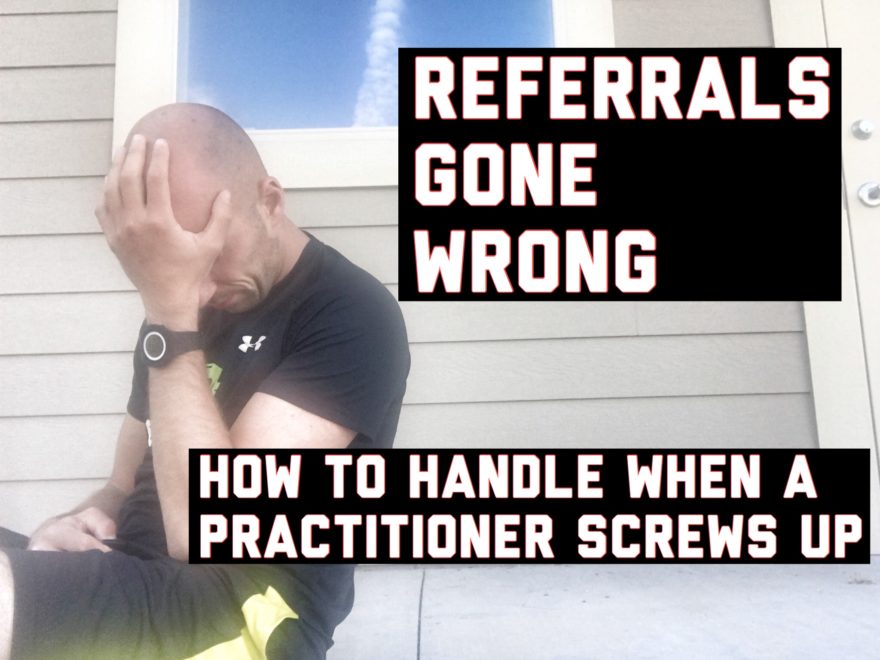Have you ever worked with someone who had a clinician or coach that did something that made you scratch your head?
Or worse yet, perform a surgery they didn’t need?
These scenarios can be beyond frustrating, but as a professional, you must maintain composure and be respectful.
We all know that this can be hard to do, when someone you care about was done wrong. Are there ways to make these transitions occur smoothly?
I answer that in today’s podcast. Give it a listen and read the modified transcript below.
Enjoy!
Referrals Gone Wrong: How to Handle When a Practitioner Screws Up
There is going to be a point in time where you are working with someone who has had an unnecessary medical procedure, or who works with a clinician who is not doing best practice or wasting the client’s time. How do we navigate this scenario without throwing the clinician or the coach under the bus? Or worse yet, making the client feel bad because they made the wrong decision?
We don’t want to do either of the above scenarios happening. Whatever occurred cannot be changed. We cannot change the past or un-ring a bell. This situation is outside of that person’s control, so there is no sense in dwelling on a mistake that practitioner or a coach has made. We want to focus on the controllables. It’s also bad business to throw these people under the bus because they could be potential referral sources for us in the future.
We have to be humble in the fact that not everyone can stay up to the current evidence base in all aspects of our practice. That is true for us as well.
I guarantee that there are certain things that we are all doing, myself included, that are not up to standard with best practice. Our scopes are too large to continually evaluate everything we do with best evidence. There are simply too many things out there, and the research too vast to keep up with everything. It’s impossible. We can only do this in a piecemeal manner.
We have to give people the benefit of the doubt, which we do not do when we throw people under the bus. So be humble and make sure you handle the handoff with class.
The unnecessary procedure
Consider the scenario in which a client underwent a procedure that was unnecessary. Maybe a lateral release of a knee or a back surgery that wasn’t warranted. How do you handle this, especially if the procedure went wrong and didn’t help?

There’s a simple way to handle this. We simply have to say that we cannot speak on the behalf of the surgeon or practitioner because we neither have the same thought process nor saw what the client looked like beforehand to make a decision. We would be operating from incomplete information to say whether or not that was the right call; given a clinician’s skillset, examination, and other unknown factors. This was likely the best decision that that practitioner could have made based on the information that was present at that time. And that’s okay.
We then follow by telling the client that we look at the problem through a different lens. We can impact things by addressing other variables.
Clients have to be comfortable with the fact that everyone they work with is operating with a degree of uncertainty with any intervention. That is, we really don’t know how anything is going to impact that person because everyone responds to interventions differently. Some people would have benefited from that surgery. Others would have not. Some people are going to benefit from the exercise selection that I give. Others will not. They have to be okay with that. We must support the decision the prior clinician made beforehand, whether or not we think it was a good or bad decision.
Poor Exercise Selection and/or Coaching
Another scenario that you may encounter is the handoff from another clinician or a coach. Perhaps the exercises or the activities that are given to the client are absolutely bonkers. Or maybe they weren’t even given any activities.
This is an easy sell, especially if the client has not gotten better. What I do in this case is not discredit what activities were done before. Instead, I say to the client: “Your activities or the treatments that you were doing before look pretty good. Because you’ve progressed from those activities, I want to give you something a little bit more challenging. So we’re going to work on this and here’s why.”
Many times, I have worked with clinicians who are doing abdominal draw-ins as an exercise. Instead of saying this is absolute garbage, I can’t believe that this gave you this, I will say: “OK, that looks pretty good.” Maybe I’ll even have them show me the exercise. “I think you have that down pat. I want to progress you to something more challenging, so what we’re going to work on instead is…” That way we’ve preserved the relationship from the handoff. We didn’t make that clinician’s look bad. In fact, we may have made them look good in that person’s mind. Then, that client does not harbor any resentment towards the clinician who may have not given something that was helpful.
If we talk in terms of progressions, and we’re going to carry on the torch from what the previous clinician has done, then all relationships are preserved.

Another possible scenario is when you use the same exercise as a coach or clinician, but they coach it differently, and not in a good way. You want to show the client a different or more effective way.
A common example that I see is when someone is squatting or deadlifting. The client will look way up, putting their neck into hyperextension. The client may say well this is how I’ve always been coach, but that doesn’t make it right.
Instead of throwing that person under the bus, what you would instead say is: “With this activity, I’m trying to make this happen. And I think you can get that more effectively by changing how you’re doing it in this way.” This works especially if you get the intended result. Then you’ve won and you didn’t have to say what the prior coach was doing was wrong. Just show them the results, and they will speak for themselves.
Avoiding Bad Practitioners
If you have a practitioner or a coach that is just egregious, has mailed it in, is not getting better, and has had multiple people that they’ve screwed up, we want to tactfully steer people away from them. We don’t want to talk smack about them or say that they’re bad.
What you should do instead is provide a better alternative. Let’s say you have a client who needs knee surgery. They ask you about surgeon x. You’ve seen several people from that surgeon and it’s just no Bueno. You do not recommend that person. You wouldn’t have them operate on your pet snake.

Instead of saying that person has shit outcomes, give the client a different option. You might say to the person that “I’ve had several people go with surgeon C, they’ve gotten incredible results, and they have the exact same problem as you. While you may be looking at surgeon X, I can’t testify to what that surgeon does because I haven’t had as many clients (say this even if you have had clients who have seen them).”
You want to push them to the person who has demonstrated good results. Just by telling the client you like a different person, and if your client likes you, they’re going to be more inclined to trust you and go with the practitioner that you want them to go to. No knocking the other clinician down is required. Let your referrals to the people you want to send them to, and lack of referrals to the people you don’t want to send them to, end the career of the egregious practitioner.
Sum Up
These are a few of the most impactful ways I help band handoffs go smoothly.
So to summarize.
- Be respectful with the handoff at all times
- Give people the benefit of the doubt because we are all operating with an incomplete knowledge base.
- Use progression and differing goals when handing off from poor exercise selection.
- Provide clients with alternative options.
What do you do when you are faced with a bad handoff from a practitioner? Comment below and let us know.


